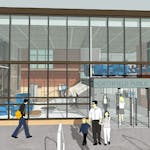The suicide bombings of two Coptic Christian churches in Egypt on Palm Sunday this year hit home in the Twin Cities, where hundreds of congregates fill the pews for services at two area churches to recite prayers, sing hymns and listen to the gospel in an alternating blend of English, Arabic and Coptic — the language of ancient Egyptians.
Though the small group of Christians is relatively unknown in the Twin Cities, its numbers are rising, with about 10 new families arriving yearly and 270 families in all. To accommodate the growth, leaders at St. Mary's Coptic Orthodox Church in South St. Paul are planning a $1 million addition to the gym so their kids have a safe place to play sports and hang out with friends. And in September, they opened the metro area's second place of worship, St. George's Coptic Orthodox Church in Plymouth.
"I think [the growth] is awesome," said Maryan Saad, 34, who sits on St. Mary's board and has attended the church for 23 years. "Honestly, I never really thought that Minnesota would have more than one [Coptic] church."
The newcomers arrive mostly from Egypt, emigrating to escape religious persecution. Others hail from established communities in states such as California or New Jersey to attend college or graduate school here, or for job opportunities, often in the medical or engineering fields.
Christianity was brought to Alexandria by Saint Mark in the first century. Coptic Christians descend from ancient Egyptians called Copts and make up about 10 percent of Egypt's population. Like other Christian Orthodox faiths, they have many shared beliefs with Roman Catholics, from the holy trinity to the Ten Commandments, and celebrate sacraments like baptism and communion. The Coptic church broke with the west after a schism in the fifth century.
Coptic Christians made global headlines in April after the Islamic State of Iraq and Syria claimed responsibility for bombing two Egyptian churches, killing about 50 people and injuring more than 100.
Such violence is part of the group's history, said the Rev. Jacob Zaki, a priest at St. Mary's.
"It's been there since day one and it will continue," Zaki said of the persecution. "The positive part of it is, it strengthens the faith of the church."
The group has quietly worshiped in South St. Paul since 1981. In 2000, church members bought their current building, an old Baptist church, importing an intricately carved wooden wall and paintings of icons from Egypt to make it feel authentically Coptic, Zaki said.
Most church members still live in South St. Paul or Inver Grove Heights, with smaller concentrations in Stillwater and Eden Prairie.
South St. Paul Mayor Jimmy Francis says he's attended the church's annual festival for several years with his family. "I know they've been good neighbors as a church," Francis said.
'It's our second home'
Religion and the church itself play an essential role in the lives of Coptic Christians, said the Rev. Youannes Tawfik, another priest at St. Mary's.
"We grow up [believing] that the church is a part of our life, not just a place we visit every week," Tawfik said. "It's our second home."
For congregants, most of them immigrants, the church provides not just a place to pray but also a sense of community and an emotional connection to their homeland.
Joe Gobran grew up as part of the only Coptic Christian family in Maple Grove and is now a senior at the University of Minnesota. He said St. Mary's connected him to his cultural heritage.
"It was cool growing up to be able to experience that culture every single week," Gobran said. "I'm multicultural — I grew up in America, so having that community of Egyptians … provided a good balance."
For some, the church acts as a bridge to understanding life in the United States. The church has brought in speakers to explain concepts like truancy and the benefits of being bilingual, because many of the children speak Arabic as well as English. Saad said her parents learned about the college application process at St. Mary's. In Egypt, children hang out at their church all summer and play sports through church-organized leagues, so it becomes not just a religious space but also a social one, she said.
In Minnesota, St. Mary's provides many summer activities, like mission trips and camps, but it's more difficult to keep kids occupied in the winter, Saad said. The gym expansion will add bathrooms, a second-floor game area and an elevator to better serve disabled and elderly visitors. Construction should begin this summer and finish by the end of the year.
Church leaders say the project is a way to ensure that the next generation of believers feels a link to the Coptic Christian church and culture.
"It's a place to gather them to play sports," Saad said. "And then it's a place where they feel like they belong."
Erin Adler • 612-673-1781


